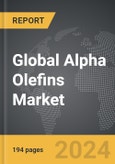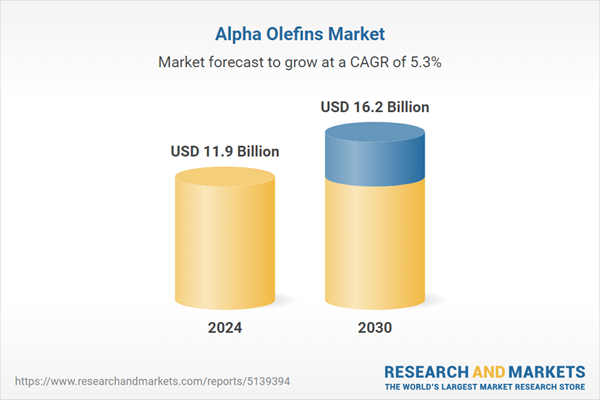Global Alpha Olefins Market - Key Trends and Drivers Summarized
Why Are Alpha Olefins Crucial in Modern Industry?
Alpha olefins are crucial components in modern industry due to their versatility and wide range of applications. These hydrocarbons, characterized by the presence of a double bond at the first carbon atom in their molecular structure, serve as key building blocks in the production of numerous chemical products. Their ability to undergo polymerization and other chemical reactions makes them invaluable in manufacturing plastics, detergents, synthetic lubricants, and various specialty chemicals. For instance, linear alpha olefins (LAOs) are extensively used in producing high-density polyethylene (HDPE), which is essential for making plastic bottles, piping, and other durable goods. The demand for alpha olefins is driven by their effectiveness in enhancing the performance characteristics of end products, such as improving strength, flexibility, and resistance to wear and tear.How Are Technological Advancements Shaping Alpha Olefin Production?
Technological advancements are significantly shaping the production and utilization of alpha olefins, leading to more efficient and sustainable processes. Innovations in catalytic technologies, such as metallocene and Ziegler-Natta catalysts, have revolutionized the polymerization process, allowing for more precise control over the molecular structure of alpha olefins. This has resulted in the production of polymers with enhanced properties tailored to specific applications. Additionally, advancements in extraction and purification techniques have improved the yield and purity of alpha olefins, making them more cost-effective and environmentally friendly. The development of bio-based alpha olefins from renewable resources is another noteworthy trend, driven by the increasing focus on sustainability and reducing the carbon footprint of chemical manufacturing. These technological improvements are not only boosting production efficiency but also expanding the range of potential applications for alpha olefins.What Trends Are Driving the Demand for Alpha Olefins?
Several key trends are driving the growing demand for alpha olefins across various industries. The expanding plastics industry remains one of the primary drivers, with alpha olefins playing a critical role in producing high-performance polyethylene and other polymers. The rise of the automotive and packaging industries, which require durable and lightweight materials, is further propelling the demand. Additionally, the increasing use of alpha olefins in the production of synthetic lubricants and surfactants for detergents and personal care products reflects their versatility and broad applicability. The trend towards greener and more sustainable products is also influencing the market, with a growing interest in bio-based alpha olefins and eco-friendly manufacturing processes. These trends highlight the importance of alpha olefins in meeting the evolving needs of various sectors and their role in driving innovation in chemical manufacturing.What Factors Are Propelling the Growth of the Alpha Olefins Market?
The growth in the alpha olefins market is driven by several factors, primarily technological advancements, expanding end-use applications, and evolving consumer preferences. Technological innovations in catalyst development and production processes have enhanced the efficiency and sustainability of alpha olefin manufacturing, making these chemicals more accessible and cost-effective. Expanding end-use applications in industries such as plastics, automotive, and personal care products are significantly boosting demand. Additionally, the growing consumer preference for high-performance and sustainable products is driving the adoption of bio-based alpha olefins and environmentally friendly production methods. Strategic partnerships and collaborations between chemical manufacturers and end-user industries are also fostering innovation and market expansion. Furthermore, regulatory support for sustainable practices and the increasing focus on reducing environmental impact are creating new opportunities for the alpha olefins market. These factors collectively ensure a robust growth trajectory for the alpha olefins market in the coming years.Report Scope
The report analyzes the Alpha Olefins market, presented in terms of market value (USD). The analysis covers the key segments and geographic regions outlined below.- Segments: Type (Linear, Branched); Application (Polyolefin Co-Monomers, Lubricants, Surfactants, Oilfield Chemicals, Other Applications).
- Geographic Regions/Countries: World; United States; Canada; Japan; China; Europe (France; Germany; Italy; United Kingdom; Spain; Russia; and Rest of Europe); Asia-Pacific (Australia; India; South Korea; and Rest of Asia-Pacific); Latin America (Argentina; Brazil; Mexico; and Rest of Latin America); Middle East (Iran; Israel; Saudi Arabia; United Arab Emirates; and Rest of Middle East); and Africa.
Key Insights:
- Market Growth: Understand the significant growth trajectory of the Polyolefin Co-Monomers Application segment, which is expected to reach US$7.3 Billion by 2030 with a CAGR of 5%. The Lubricants Application segment is also set to grow at 5.7% CAGR over the analysis period.
- Regional Analysis: Gain insights into the U.S. market, valued at $3.1 Billion in 2024, and China, forecasted to grow at an impressive 8.1% CAGR to reach $3.7 Billion by 2030. Discover growth trends in other key regions, including Japan, Canada, Germany, and the Asia-Pacific.
Why You Should Buy This Report:
- Detailed Market Analysis: Access a thorough analysis of the Global Alpha Olefins Market, covering all major geographic regions and market segments.
- Competitive Insights: Get an overview of the competitive landscape, including the market presence of major players across different geographies.
- Future Trends and Drivers: Understand the key trends and drivers shaping the future of the Global Alpha Olefins Market.
- Actionable Insights: Benefit from actionable insights that can help you identify new revenue opportunities and make strategic business decisions.
Key Questions Answered:
- How is the Global Alpha Olefins Market expected to evolve by 2030?
- What are the main drivers and restraints affecting the market?
- Which market segments will grow the most over the forecast period?
- How will market shares for different regions and segments change by 2030?
- Who are the leading players in the market, and what are their prospects?
Report Features:
- Comprehensive Market Data: Independent analysis of annual sales and market forecasts in US$ Million from 2024 to 2030.
- In-Depth Regional Analysis: Detailed insights into key markets, including the U.S., China, Japan, Canada, Europe, Asia-Pacific, Latin America, Middle East, and Africa.
- Company Profiles: Coverage of players such as Chevron Phillips Chemical Company LP, Dow, Inc., DuPont de Nemours, Inc., Evonik Industries AG, ExxonMobil Corporation and more.
- Complimentary Updates: Receive free report updates for one year to keep you informed of the latest market developments.
Some of the 42 companies featured in this Alpha Olefins market report include:
- Chevron Phillips Chemical Company LP
- Dow, Inc.
- DuPont de Nemours, Inc.
- Evonik Industries AG
- ExxonMobil Corporation
- INEOS Group AG
- PJSC Nizhnekamskneftekhim
- Qatar Chemical Company Ltd.
- Royal Dutch Shell PLC
- SABIC (Saudi Basic Industries Corporation)
- Sasol Ltd.
This edition integrates the latest global trade and economic shifts into comprehensive market analysis. Key updates include:
- Tariff and Trade Impact: Insights into global tariff negotiations across 180+ countries, with analysis of supply chain turbulence, sourcing disruptions, and geographic realignment. Special focus on 2025 as a pivotal year for trade tensions, including updated perspectives on the Trump-era tariffs.
- Adjusted Forecasts and Analytics: Revised global and regional market forecasts through 2030, incorporating tariff effects, economic uncertainty, and structural changes in globalization. Includes historical analysis from 2015 to 2023.
- Strategic Market Dynamics: Evaluation of revised market prospects, regional outlooks, and key economic indicators such as population and urbanization trends.
- Innovation & Technology Trends: Latest developments in product and process innovation, emerging technologies, and key industry drivers shaping the competitive landscape.
- Competitive Intelligence: Updated global market share estimates for 2025, competitive positioning of major players (Strong/Active/Niche/Trivial), and refined focus on leading global brands and core players.
- Expert Insight & Commentary: Strategic analysis from economists, trade experts, and domain specialists to contextualize market shifts and identify emerging opportunities.
Table of Contents
Companies Mentioned (Partial List)
A selection of companies mentioned in this report includes, but is not limited to:
- Chevron Phillips Chemical Company LP
- Dow, Inc.
- DuPont de Nemours, Inc.
- Evonik Industries AG
- ExxonMobil Corporation
- INEOS Group AG
- PJSC Nizhnekamskneftekhim
- Qatar Chemical Company Ltd.
- Royal Dutch Shell PLC
- SABIC (Saudi Basic Industries Corporation)
- Sasol Ltd.
Table Information
| Report Attribute | Details |
|---|---|
| No. of Pages | 194 |
| Published | December 2025 |
| Forecast Period | 2024 - 2030 |
| Estimated Market Value ( USD | $ 11.9 Billion |
| Forecasted Market Value ( USD | $ 16.2 Billion |
| Compound Annual Growth Rate | 5.3% |
| Regions Covered | Global |









